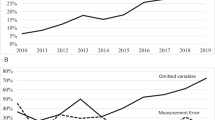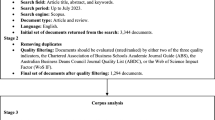Abstract
This paper shows the importance of goal vectors G in measuring and dealing with DEA inefficiencies. It emphasizes the advantages of the family of additive relative to the traditional oriented DEA models and shifts the primary emphasis to measuring inefficiency rather than efficiency. This new (raw) inefficiency measure RIN incorporates both the traditional DEA efficiency and the DEA slacks and provides the background for a new approach to the Malmquist Index. The final section points out some deficiencies in existing computational procedures for selecting G and calls for continued research on the selection process, as well as showing a role for G in returns to scale studies.
Similar content being viewed by others
References
Balk, B. M. (1993). “Malmquist Productivity Indexes and Fisher Ideal Indexes: Comment.” The Economic Journal 103, 680-682.
Banker, R. D., and R. M. Thrall. (1992). “Estimation of Returns to Scale using Data Envelopment Analysis.” European Journal of Operations Research 62, 74-84.
Charnes, A.,W.W. Cooper, and R. M. Thrall. (1991). “A Structure for Classifying and Characterizing Efficiencies and Inefficiencies in Data Envelopment Analysis.” The Journal of Productivity Analysis 2, 197-237.
Cooper, W.W., Kyung Sam Park, and J. T. Pastor. (1999). “RAM: A Range Adjusted Measure of Inefficiency for Use with Additive Models and Relations to Other Models and Measures in DEA.” The Journal of Productivity Analysis 11, 5-42.
Cooper, W.W., and J. T. Pastor. (1997). “Generalized Efficiency Measures (GEMS) and Model Relations for Use in DEA.” Working Paper, Dept. Est. Inv. Oper. Universidad Alicante, Alicante, Spain.
Cooper, W.W., R. G. Thompson, and R. M. Thrall. (1996). “Introduction: Extensions and New Developments in DEA.” Annals of Operations Research 66, 3-45.
Dula, J. H., and B. L. Hickman. (1997 version). “Effects of Excluding the Column Being Scored from the DEA Envelopment LP Technology Matrix.” Technical report 95-3, Department of Computer Science, University of Nebraska at Omaha. To appear in the Journal of the Operational Research Society.
Färe, R., and S. Grosskopf. (1992). “Malmquist Productivity Indexes and Fisher Ideal Indexes.” Economic Journal, 158-160.
Grifell-Tatje, E., C. A. K. Lovell, and J. T. Pastor. (1996). “A Quasi-Malmquist Productivity Index.” Working Paper.
Jahanshahloo, G. R., and M. R. Alirazaee. “A Complete Efficiency Ranking of Decision Making Units: An Application to the Teacher Training University.” Working paper.
Seiford, L. H., and R. M. Thrall. (1990). “Recent Developments in DEA: The Mathematical Programming Approach.” Journal of Econometrics 46, 1/2, Oct./Nov., 7-38.
Thompson, R. G., et al. (1997). “Linked-Cone Profit Ratio Estimates of U.S. Total Factor Productivity Growth Using DEA/AR Methods.” In H. Amman et al. (eds.), Computational Approaches to Economic Problems. Kluwer Academic Publishers, 79-90.
Thrall, R. M. (1996). “Duality, Classifications and Slacks in DEA.” In W. W. Cooper et al. (eds.), Annals of Operations Research 66, 109-138.
Author information
Authors and Affiliations
Rights and permissions
About this article
Cite this article
Thrall, R.M. Measures in DEA with an Application to the Malmquist Index. Journal of Productivity Analysis 13, 125–137 (2000). https://doi.org/10.1023/A:1007800830737
Issue Date:
DOI: https://doi.org/10.1023/A:1007800830737




